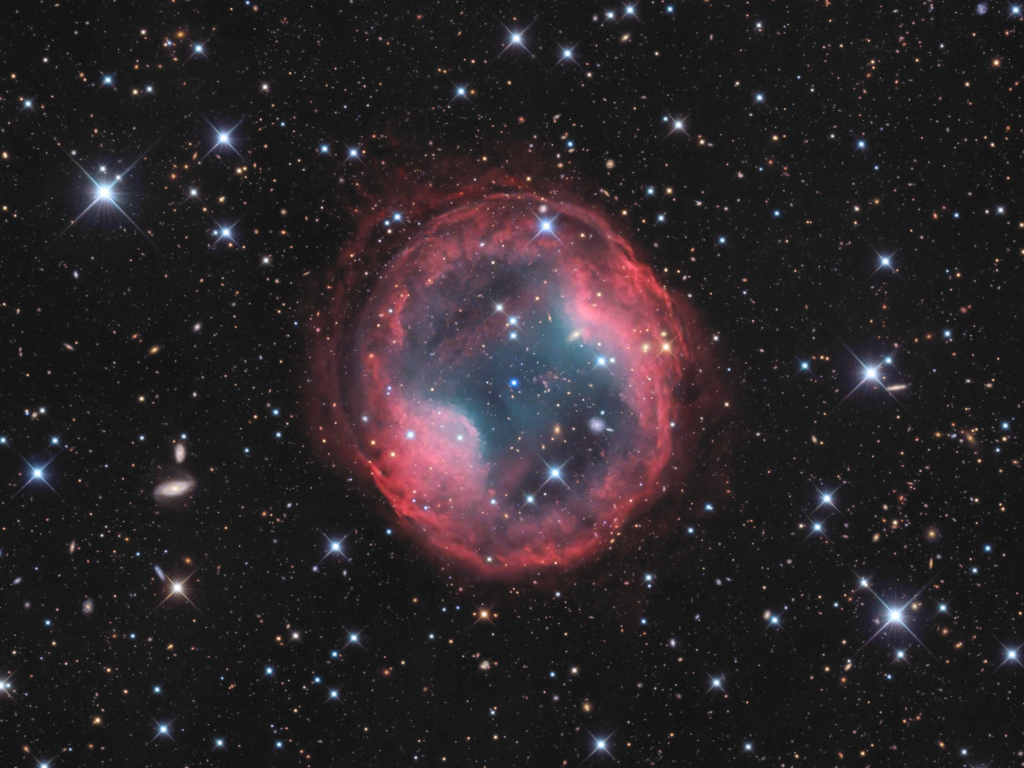24. February 2023
行星形星雲 Jones-Emberson 1

探索宇宙1!逐工會揀一幅無仝款 ê 影像抑是相片,𤆬你熟似咱這个迷人 ê 宇宙,閣有專業天文學者2為你解說3。
- 原始文章:Jones-Emberson 1
- 影像來源 kah 版權:Serge Brunier, Jean-François Bax, David Vernet, C2PU/OCA
- 台文翻譯:An-Li Tsai (NCU)
[漢羅] 行星形星雲 Jones-Emberson 1
行星形星雲 Jones-Emberson 1 是欲死 ê 類太陽恆星 ê 殮布。 伊 kah 地球 ê 距離是差 1600 光年,tī 目睭足利 ê 天貓座遐。 恆星核心先是進行水素 ê 核融合反應,煞落來是日素 ê 核融合反應。 幾若十億年了後,這寡元素攏燒了矣。 這時,這粒欲死 ê 恆星 ê 大氣,去予 hiù tùi 星際空間去。 這个脹大 ê 殘骸差不多有 4 光年闊。 咱會使看著行星形星雲 ê 中心遐,是恆星核燒賰 ê 部份,是一粒藍色高溫 ê 白矮星。 這个星雲嘛叫做 PK 164 +31.1,伊足暗–ê,用望遠鏡 ê 目鏡是足歹影著。 毋過這張 深空 ê 闊頻影像 是 kā 22 點鐘久 ê 感光疊做一張–ê,所以確實會當看著足足足清楚 ê 細節。 Tī 這个清楚 ê 視野內底,有咱銀河系內 ê 恆星,kah 散佈 tī 宇宙 ê 背景星系。 行星形星雲 Jones-Emberson 1 tī 這个宇宙舞台頂懸 ê 時間,是 足短–ê。 伊會 tī 紲落來幾若千年 ê 時間內,沓沓仔消失。 毋過中心彼粒高溫 ê 白矮星,愛等幾若 十億 年 ê 時間才會變冷–去。
[POJ] Kiâⁿ-chheⁿ-hêng seng-hûn Jones-Emberson 1
Kiâⁿ-chheⁿ-hêng seng-hûn Jones-Emberson 1 sī beh sí ê lūi-thài-iông hêng-chheⁿ ê liām-pò͘. I kah Tē-kiû ê kū-lī sī chha 1600 kng-nî, tī ba̍k-chiu chiok lāi ê Thian-niau-chō hiah. Hêng-chheⁿ he̍k-sim seng sī chìn-hêng chúi-sò͘ ê he̍k-iông-ha̍p hoán-èng, sòa-lo̍h-lâi sī ji̍t-sò͘ ê he̍k-iông-ha̍p hoán-èng. Kúi-ā cha̍p-ek nî liáu-āu, chit-kóa goân-sò͘ lóng sio liáu–ah. Chit-sî, chit-lia̍p beh sí ê hêng-chheⁿ ê tōa-khì, khì hō͘ hiù tùi seng-chè-khong-kan khì. Chit ê tiùⁿ-tōa ê chân-hâi chha-put-to ū 4 kng-nî khoah. Lán ē-sái khòaⁿ-tio̍h kiâⁿ-chheⁿ-hêng seng-hûn ê tiong-sim hiah, sī hêng-chheⁿ-he̍k sio chhun ê pō͘-hūn, sī chi̍t-lia̍p nâ-sek ko-un ê pe̍h-é-chheⁿ. Chit-ê seng-hûn mā kiò-chò PK 164 +31.1, i chiok àm–ê, iōng bōng-oán-kiàⁿ ê bo̍k-kiàⁿ sī chiok phái iáⁿ–tio̍h. M̄-koh chit-tiuⁿ chhim-khòng ê khoah-pîn iáⁿ-siōng sī kā 22 tiám-cheng kú ê kám-kng tha̍h chò chi̍t-tiuⁿ–ê, só͘-í khak-si̍t ē-tàng khòaⁿ-tio̍h chiok chiok chiok chheng-chhó ê sè-chiat. Tī chit-ê chheng-chhó ê sī-iá lāi-té, ū lán Gîn-hô-hē lāi-té ê hêng-chheⁿ, kah sàn-pò͘ tī ú-tiū ê pōe-kéng seng-hē. Kiâⁿ-chheⁿ-hêng seng-hûn Jones-Emberson 1 tī chit-ê ú-tiū bú-tâi téng-koân ê sî-kan, sī chiok té–ê. I ē tī sòa-lo̍h-lâi kúi-ā chheng nî ê sî-kan lāi, tau̍h-tau̍h-á siau-sit. M̄-koh tiong-sim hit-lia̍p ko-un ê pe̍h-é-chheⁿ, ài tán kúi-ā cha̍p-ek nî ê sî-kan chiah ē piàn léng–khì.
[KIP] Kiânn-tshenn-hîng sing-hûn Jones-Emberson 1
Kiânn-tshenn-hîng sing-hûn Jones-Emberson 1 sī beh sí ê luī-thài-iông hîng-tshenn ê liām-pòo. I kah Tē-kiû ê kū-lī sī tsha 1600 kng-nî, tī ba̍k-tsiu tsiok lāi ê Thian-niau-tsō hiah. Hîng-tshenn hi̍k-sim sing sī tsìn-hîng tsuí-sòo ê hi̍k-iông-ha̍p huán-ìng, suà-lo̍h-lâi sī ji̍t-sòo ê hi̍k-iông-ha̍p huán-ìng. Kuí-ā tsa̍p-ik nî liáu-āu, tsit-kuá guân-sòo lóng sio liáu–ah. Tsit-sî, tsit-lia̍p beh sí ê hîng-tshenn ê tuā-khì, khì hōo hiù tuì sing-tsè-khong-kan khì. Tsit ê tiùnn-tuā ê tsân-hâi tsha-put-to ū 4 kng-nî khuah. Lán ē-sái khuànn-tio̍h kiânn-tshenn-hîng sing-hûn ê tiong-sim hiah, sī hîng-tshenn-hi̍k sio tshun ê pōo-hūn, sī tsi̍t-lia̍p nâ-sik ko-un ê pe̍h-é-tshenn. Tsit-ê sing-hûn mā kiò-tsò PK 164 +31.1, i tsiok àm–ê, iōng bōng-uán-kiànn ê bo̍k-kiànn sī tsiok phái iánn–tio̍h. M̄-koh tsit-tiunn tshim-khòng ê khuah-pîn iánn-siōng sī kā 22 tiám-tsing kú ê kám-kng tha̍h tsò tsi̍t-tiunn–ê, sóo-í khak-si̍t ē-tàng khuànn-tio̍h tsiok tsiok tsiok tshing-tshó ê sè-tsiat. Tī tsit-ê tshing-tshó ê sī-iá lāi-té, ū lán Gîn-hô-hē lāi-té ê hîng-tshenn, kah sàn-pòo tī ú-tiū ê puē-kíng sing-hē. Kiânn-tshenn-hîng sing-hûn Jones-Emberson 1 tī tsit-ê ú-tiū bú-tâi tíng-kuân ê sî-kan, sī tsiok té–ê. I ē tī suà-lo̍h-lâi kuí-ā tshing nî ê sî-kan lāi, ta̍uh-ta̍uh-á siau-sit. M̄-koh tiong-sim hit-lia̍p ko-un ê pe̍h-é-tshenn, ài tán kuí-ā tsa̍p-ik nî ê sî-kan tsiah ē piàn líng–khì.
[English] Jones-Emberson 1
Planetary nebula Jones-Emberson 1 is the death shroud of a dying Sun-like star. It lies some 1,600 light-years from Earth toward the sharp-eyed constellation Lynx. About 4 light-years across, the expanding remnant of the dying star’s atmosphere was shrugged off into interstellar space, as the star’s central supply of hydrogen and then helium for fusion was finally depleted after billions of years. Visible near the center of the planetary nebula is what remains of the stellar core, a blue-hot white dwarf star. Also known as PK 164 +31.1, the nebula is faint and very difficult to glimpse at a telescope’s eyepiece. But this deep broadband image combining 22 hours of exposure time does show it off in exceptional detail. Stars within our own Milky Way galaxy as well as background galaxies across the universe are scattered through the clear field of view. Ephemeral on the cosmic stage, Jones-Emberson 1 will fade away over the next few thousand years. Its hot, central white dwarf star will take billions of years to cool.
詞彙學習(漢羅/POJ/KIP/華語/English)
- 【類太陽恆星】lūi-thài-iông hêng-chheⁿ/luī-thài-iông hîng-tshenn/類太陽恆星/Sun-like star
- 【行星形星雲】kiâⁿ-chheⁿ-hêng seng-hûn/kiânn-tshenn-hîng sing-hûn/行星狀星雲/planetary nebula
- 【殮布】liām-pò͘/liām-pòo/裹尸布/death shroud
- 【天貓座】Thian-niau-chō/Thian-niau-tsō/天貓座/Lynx
- 【核融合反應】he̍k-iông-ha̍p hoán-èng/hi̍k-iông-ha̍p huán-ìng/核融合反應/fusion
- 【水素】chúi-sò͘/tsuí-sòo/氫/hydrogen
- 【日素】ji̍t-sò͘/ji̍t-sòo/氦/helium
- 【星際空間】seng-chè-khong-kan/sing-tsè-khong-kan/星際空間/interstellar space
- 【白矮星】pe̍h-é-chheⁿ/pe̍h-é-tshenn/白矮星/white dwarf
- 【PK 164 +31.1】PK it-lio̍k-sù ka saⁿ-it tiám it/PK it-lio̍k-sù ka sann-it tiám it/PK 164 +31.1/PK 164 +31.1
- 【目鏡】bo̍k-kiàⁿ/bo̍k-kiànn/目鏡/eyepiece
- 【闊頻】khoah-pîn/khuah-pîn/寬頻/broadband
- 【視野】sī-iá/sī-iá/視野/field of view
- 【恆星核】hêng-chheⁿ-he̍k/hîng-tshenn-hi̍k/恆星核/the stellar core
- 【感光】kám-kng/kám-kng/曝光/exposure